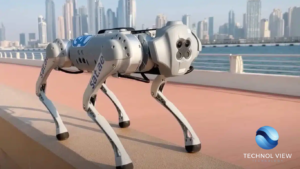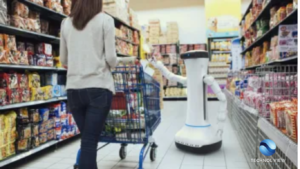What Are Robots? Everything You Need To Know

Introduction:
As we travel back to a time not too long ago, when robots were only a whisper in the dark worlds of science fiction, we can’t help but be amazed at how quickly this fantastic idea turned into a reality that we can see everywhere. In this confusing article, we will delve into the intricate tapestry of robot technology’s basics, untangle the many pros and cons that come with using robots in a wide range of fields, explore the vast landscapes where they are ubiquitous, and look into the fuzzy horizon of the bright future that lies ahead in the mysterious field of robotics.
How robot technology works:
By its very core, a robot is a complex mechanical master made to dance through tasks either fully or partially on its own, with the natural ability to sense and plan reactions to its changing surroundings. A robot’s muscles are:
- Its body or frame.
- It has moving parts (actuators) that make it move.
- Its sensors act like an electronic nervous system to sense things.
- It’s a smart driver that makes decisions.
- The power source that gives it life.
Robots can move and move things around with great skill thanks to actuators, which are like invisible motors and servos. Sensors, which include simple infrared scanners, high-tech cameras, and LIDAR, give the robot a colorful view of its surroundings. The controller, like a conductor leading a symphony of choices, usually takes the form of a computer or microcontroller. This is where the magic happens: sense inputs are processed, and directions are sent to the actuators. Power sources, which give this mechanical giant its breath, usually come in the form of batteries or electrical outlets. They provide the robot with the energy it needs to keep dancing nonstop.
The Way Robots Work:
Take a look at the detailed dance, a mesmerizing performance made from the robot’s sense web. The all-powerful manager is given data, which is a mysterious language of natural details. This person who makes choices works in the inner sanctum of processing and comes up with orders that are filled with the pure knowledge of binary thoughts.
They are like digital prophet who spells out the dance that the motors will do. This complicated triangle of sensing, processing, and acting flows through the robot’s mechanical blood and makes up its psychological rhythm. There are very advanced levels of robotics where machine learning algorithms and artificial intelligence work together to give robots the ability to learn from their experiences and become smarter.
Why robotics is a good idea:
Watch as the brightest levels of efficiency and accuracy fall from the top of the robotic world. In the harsh environment of the industry, robots are better than humans at doing complicated tasks with a level of accuracy that exceeds human perfection. As robots gallivant into dangerous realms, safety becomes like a ballet dance, making human involvement seem out of place in nuclear facilities or disaster-stricken realms.
The never-ending nocturne of 24/7 operations plays out, a rich fabric made from the threads of a robot’s insomniac work. Through the robotic advance, a strange exploration of hostile areas comes to life: a cosmic dance of space exploration, deep-sea missions, and surveillance missions in the grip of danger.
Not-so-good things about robotics:
Still, shadows dance in this ballet of the stars. As the threat of losing a job becomes real, a jarring sound reverberates, casting a haunting nocturne over the job market. Massive upfront costs, like an erupting comet from space, make it hard for new industries and small businesses to find their way through the maze of robotic assimilation.
The music falls apart in the hallways of complexity and upkeep. Even though robots are made to do epics on their own, they strangely need wise people who can do the magic of complex upkeep and fixes. The sudden sound of moral problems echoes—the use of self-driving guns and the robotic minuet in caring roles—all calling people to think about their morals.

Every Job Has a Robot:
The greatest work of computer integration is spread out like a Pollock painting, with colors of revolutionary fervor all over it.
Alchemist:
Robots are like alchemists in manufacturing. They move effortlessly between quality control, assembly, and welding, creating a mix of higher speed, lower costs, and higher product quality. It’s like the peak in the opening to healthcare, where robots dance through surgery orchestras and don the role of rehabilitation exoskeletons, dancing with healthcare workers.
Agricultural Use:
The agricultural symphony starts with robots planting, harvesting, and conducting a chimerical concerto of field tracking. This marks the beginning of the age of precision agriculture and the peak of optimal resource use.
Use In Vehicle:
The dignified minuet of automatic guided vehicles and robotic arms can be seen in logistics and storage. They make sorting, packing, and transporting things a dance of perfect accuracy.
Education:
In this educational fantasy, robots take on the role of teachers and help students find their way through the maze of programming and fixing problems. It’s like a dance of knowledge in the school hallways.
The Future of Robotics:
The history of robotics is complicated, with the warp and weft of artificial intelligence and machine learning weaving through it all. There is a cosmic dance of the bizarre and smart robots who are very good at learning and adapting twirl into the spotlight.
Collaboration Between Humans And Robots:
It becomes a theme, a smooth rhythm in which robots don’t take over human decision-making but instead work with humans to improve their skills and spark the fire of increased output.
Bio-inspired Robots:
It changes into a forest idyll where robots imitate nature’s unspoken grace by adding speed, flexibility, and resilience to their skills in a way that sounds like biological systems.
Autonomous rovers and drones dance across strange landscapes in space travel, a kind of cosmic dancing that sets the stage for human journeys to faraway worlds.
Helping people is where the final peak happens. This is where socially intelligent robots become friends for older people, rescuers for disabled people, and organizers of housework.
Conclusion:
After being a part of science fiction for a long time, the robotic world has become a part of our everyday lives and a sign of an exciting future. Robots move through space like a dance, from the complicated basics of robot technology to their widespread use in many areas, the symphony of pros and cons, and the vague shapes of the future.
As we dance through this age of amazing technology, the perfect mix of careful thought and moral reflection stands watch to make sure that the magic of robots is used for the better good as problems pop up like stardust in this dance of the stars, the robotic fabric will unfold, spreading its multicolored brightness across the canvas of human progress.

